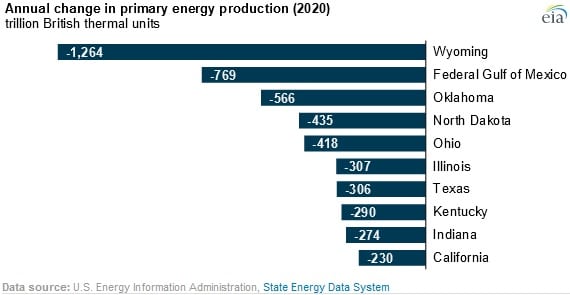U.S. Coal Production Declined by a Record 25 Percent in 2020: EIA

In 2020, seven U.S. states experienced the largest declines in their annual energy production in the last six decades, according to an Aug. 8 report from the U.S. Energy Information Administration. This is due to the decrease in economic activity due to the COVID-19 pandemic. Among all the states in the U.S., Wyoming experienced a huge drop in total energy production, a whopping dip of 1.2 quadrillion Btu due to a drop in coal production. U.S. energy production declined by nearly 6 percent, from about 102 quadrillion Btu in 2019 to 96 quadrillion Btu in 2020, the lowest since 2017. Coal production fell by a record 25 percent while renewables saw a modest increase of less than one percent.
Annual Change in Primary U.S. Energy Production in 2020
Coal
- Coal production in 2020 fell by 25 percent to 10.7 quadrillion Btu from its 1998 high of 23.9 quadrillion Btu, the fourth-lowest level since 1962 due to the closing of 151 mines.
- Coal production in Indiana, Kentucky, and Wyoming fell by 37 percent, 33percent, and 21 percent, respectively, while Wyoming saw the maximum decrease in coal production volume by over 1 quadrillion Btu, the most among the states.
- However, in 2021, coal production is expected to increase from its 2020 levels.
- Arizona’s last coal mine in the Black Mesa field was closed in 2019, leading to cease of coal production in the state.
Natural Gas
- Natural gas production in 2020 fell by 0.1 percent to 41.6 quadrillion Btu from a high of 41.7 quadrillion Btu in 2019.
- Oklahoma saw a decrease in marketed natural gas by 0.300 quadrillion Btu because of a fall in shale gas production by 20 percent.
- It is noted that natural gas in 2020 was in high demand compared to coal for power generation due to its low price.
Crude Oil
- Crude oil production in 2020 fell by 8 percent to 23.5 quadrillion Btu from a high of 25.6 quadrillion Btu in 2019.
- Because of the COVID-19 pandemic, crude oil production fell in almost 29 states out of 32 due to less demand for transportation fuels.
- However, New Mexico saw an increase in oil production by 11 percent compared with 2019, the second largest crude oil-producing state in 2021.
Nuclear Energy
- Nuclear energy production in 2020 fell by 2 percent to 8.2 quadrillion Btu from its 2007 high of 8.5 quadrillion Btu.
- The decline in production is due to the closure of nuclear power plants in Massachusetts (Pilgrim) and lowa (Duane Arnoid).
Renewable Energy
- Renewable energy production in 2020 increased by 0.4 percent due to the rise in solar and wind energy production by 19 percent and 13 percent, respectively.
- Overall green energy production increased to 11.6 quadrillion Btu from its 1960 low of 2.9 quadrillion Btu.
- California saw a decline in hydro energy production by 45 percent, the most among any state due to extensive drought.
EnerKnol Pulses like this one are powered by the EnerKnol Platform—the first comprehensive database for real-time energy policy tracking. Sign up for a free trial below for access to key regulatory data and deep industry insights across the energy spectrum.
ACCESS FREE TRIAL